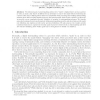Free Online Productivity Tools
i2Speak
i2Symbol
i2OCR
iTex2Img
iWeb2Print
iWeb2Shot
i2Type
iPdf2Split
iPdf2Merge
i2Bopomofo
i2Arabic
i2Style
i2Image
i2PDF
iLatex2Rtf
Sci2ools
TCC
2007
Springer
2007
Springer
From Weak to Strong Watermarking
The informal goal of a watermarking scheme is to “mark” a digital object, such as a picture or video, in such a way that it is difficult for an adversary to remove the mark without destroying the content of the object. Although there has been considerable work proposing and breaking watermarking schemes, there has been little attention given to the formal security goals of such a scheme. In this work, we provide a new complexity-theoretic definition of security for watermarking schemes. We describe some shortcomings of previous attempts at defining watermarking security, and show that security under our definition also implies security under previous definitions. We also propose two weaker security conditions that seem to capture the security goals of practice-oriented work on watermarking and show how schemes satisfying these weaker goals can be strengthened to satisfy our definition.
| Added | 09 Jun 2010 |
| Updated | 09 Jun 2010 |
| Type | Conference |
| Year | 2007 |
| Where | TCC |
| Authors | Nicholas Hopper, David Molnar, David Wagner |
Comments (0)

